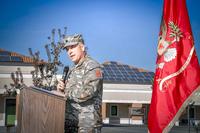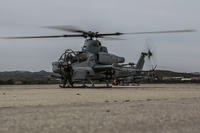FORT GEORGE G. MEADE, Md. -- Whether trying to coordinate multiple aircraft in a three-dimensional battlespace, calling in precise close air support or evacuating personnel caught behind enemy lines – effective multitasking is at the heart of the mission for Air Force special operators.
Researchers with the 711th Human Performance Wing at Wright-Patterson Air Force Base, Ohio, are now working to make missions lighter and faster for Airmen by testing Google Glass and its head-mounted optical see-through display technology, for potential battlefield use.
Still in beta-testing as part of Google's Explorer program, the trials are conducted by the Battlefield Air Targeting, Man-Aided Knowledge, or BATMA(N) group, an advanced technology demonstration and research program commissioned by the Air Force Special Operations Command to develop, build and investigate advanced wearable technologies.
“Trying to interact in the battlespace places a lot of burden on the dismounted battlefield Airmen,” said Dr. Gregory Burnett, the chief engineer of the BATMA(N) program. “BATMA(N) is a constant endeavor to try to improve tactical decision making and reduce the human error associated with our Airmen’s mission set.”
A combination between a hardware and software product, Google Glass is based on Google’s own Android operating system and can leverage a great majority of modern smartphone capabilities while remaining light and allowing for largely hands-free operation.
“Its most distinguishing feature is that its screen sits above the user’s right eye,” said Andres Calvo, a software developer and civilian contractor with the 711th HPW. “What that means is that the screen is off by default. Whenever you need to access the information, you either look up, or you touch on the trackpad and only then will the screen turn on.”
While aircraft pilots have been using variations of heads-up displays for years, with the latest iteration being incorporated in the new helmets worn by F-35 Lightning II pilots, the engineers said the tactical ground missions put high demands on the operators over extended periods of time and varying environments.
One possible use being investigated in preliminary studies, Calvo said, is a medical app that would allow first responders in the pararescue community to monitor vitals of multiple casualties, without taking their hands off patients or weapons.
“Since (pararescuemen) have the need to recover personnel, it’s beneficial for them to monitor many people at once,” Calvo said. “The app aims to better enable them to assess who needs urgent medical attention, and it would improve their accountability. Google Glass is a display that has the potential to display that information. So, if a (pararescueman) has the need to see somebody’s vitals, immediately and urgently, Google Glass could fill that need.”
With the aim to reduce the overall size, weight and power required of the dismounted operator, engineers attempt to move away from clunky, ruggedized laptops with short battery life. Google Glass is intended to work within an ensemble in combination with cellphones or tablet devices that will hold the data and supplement the heads-up display.
“Google Glass is not going to be a stand-alone interface,” Calvo said. “It’s also coupled with an (android) device, so if a (pararescueman) is in need of viewing information that is more in-depth, or too dense to be viewed through Google Glass, then the smartphone would be a good place to do that.”
Google Glass is only one of many research endeavors BATMA(N) is conducting within the 711th HPW, Burnett said. The team is also investigating similar technologies, such as BAE Systems’ Q-Warrior display technology, for Air Force viability.
“Heads-up displays and auditory cueing interfaces are really interesting items because we are trying to offload and augment the information the warfighter has to interact with on the battlefield in order to improve mission effectiveness,” Burnett said. “We look at visual, auditory and tactile interfaces that serve to leverage all the human perception channels to provide real-time battlefield data in the most intuitive fashion. So, if the Airman is visually overstimulated, we can offload that into auditory information so that he can still process information in a very chaotic scenario.”
To assess how the interface affects users’ stimulation, the group uses a variety of test approaches.
“The lab here has a very diverse group of people,” Calvo said. “Not only do we have engineers and software developers, but we also have human factors specialists and behavioral scientists. So whenever we approach a problem we have a very multidisciplinary approach to it.”
To better understand the needs of the user, the engineers bring their developments to regular test and feedback sessions with Airmen operators.
“We regularly interact with subject matter experts from active-duty units in the pararescue and (the joint terminal attack control) community to assess what information would be more relevant and intuitive for them,” Burnett said. ”They are involved in the design of these new applications we present on Google Glass.”
The engineers use their feedback to improve the applications with lessons learned.
“Usually we use an iterative approach for design,” Calvo said. “In other words, we try to come up with a concept for a particular application and then we let them try it out. Then, not only do we gather the feedback from the users, but we also watch them use it. Based on that, we try to articulate what parts of the application need refinement. It’s really after iteration after iteration that a product starts taking shape.”
While many research projects at the Air Force Research Laboratory have a long-term focus, the BATMA(N) group’s efforts are notably short-term -- with some technologies adopted within as little as two months, Burnett said.
“What is exciting is that it is a very quick-reaction tempo,” Burnett said. “We are focusing on more of a rapid, near-term solution. Having the ability to rapidly (address) urgent deficiencies for the warfighter makes the work challenging, yet very rewarding … It is motivating to have a short suspense because it requires you to produce a viable solution that really answers a real and urgent need.”
Despite the challenges of current budgetary constraints, Burnett said it is important to keep future technology needs in sight.
“We always want to keep one step ahead of our adversaries,” Burnett said. “To remain relevant and to make sure the government stays on top of new developments, we continuously look to the internal sources and programs, as well as the civilian sector, so that we can bring in, from both sides, the latest and greatest capabilities to provide enhanced capabilities to the warfighter.”
No matter whether the service will adopt Google Glass or a similar product, the engineers say they never lose focus of their mission to equip Airmen on the front lines.
“Our internal motivation is to better equip the warfighter so they can come home safely,” Burnett said. “At the end of the day, we know the work we’re doing is directly impacting the survivability of our warfighters in the field. That is very motivating to us … when we really distill it all down to the basics, it’s about us caring for the human (aspect of missions) and their challenge set.”




























